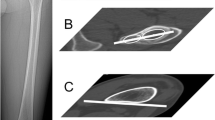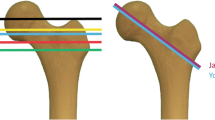Abstract
Introduction
Re-establishing anatomic rotational alignment of shaft fractures of the lower extremities remains challenging. Clinical evaluation in combination with radiological measurements is important in pre- and post-surgical assessment. Based on computed tomography (CT), a range of reference values for femoral torsion (FT) and tibial torsion (TT) have historically been reported, which require standardization to optimize the significant intra- and inter-observer variability. The aims of this study were (re-)evaluation of the reference FT and TT angles, determination of the normal intra-individual side-to-side torsional differences to aid the surgical decision-making process for reoperation, and development of a novel 3D measurement method for FT.
Materials and methods
In this retrospective study, we included 55 patients, without any known torsional deformities of the lower extremities. Two radiologists, independently, measured the rotational profile of the femora using the Hernandez and Weiner CT methods for FT, and the tibiae using the bimalleolar method for TT. The intra-individual side-to-side difference in paired femora and paired tibiae was determined. A 3D technique for FT assessment using InSpace® was designed.
Results
FT and TT demographic values were lower than previously reported, with mean FT values of 5.1°–8.8° and mean TT values of 25.5°–27.7°. Maximal side-to-side differences were 12°–13° for FT and 12° for TT. The Weiner method for FT was less variable than the Hernandez method. The new 3D method was equivocal to the conventional CT measurements.
Conclusion
The results from this study showed that the maximal side-to-side tolerance in asymptomatic normal adult lower extremities is 12°–13° for FT and 12° for TT, which could be a useful threshold for surgeons as indication for revision surgery (e.g., derotational osteotomy). We developed a new 3D CT method for FT measurement which is similar to 2D and could be used in the future for virtual 3D planning.



Similar content being viewed by others
Abbreviations
- FT:
-
Femoral torsion
- FNA:
-
Femoral neck axis
- TT:
-
Tibial torsion
- CT:
-
Computed tomography
- 3D:
-
Three-dimensional
References
Lindsey JD, Krieg JC (2011) Femoral malrotation following intramedullary nail fixation. J Am Acad Orthop Surg 19(1):17–26
Omar M, Suero EM, Hawi N, Decker S, Krettek C, Citak M (2015) Preoperative virtual reduction reduces femoral malrotation in the treatment of bilateral femoral shaft fractures. Arch Orthop Trauma Surg 135:1385–1389
Kaiser P, Attal R, Kammerer M, Thauerer M, Hamberger L, Mayr R et al (2016) Significant differences in femoral torsion values depending on the CT measurement technique. Arch Orthop Trauma Surg 136(9):1259–1264
Dugdale TW, Degnan GG, Turen CH (1990) The use of computed tomographic scan to assess femoral malrotation after intramedullary nailing. A case report. Clin Orthop Relat Res 279:258–263
Hartel MJ, Petersik A, Schmidt A, Kendoff D, Nüchtern J, Rueger JM et al (2016) Determination of femoral neck angle and torsion angle utilizing a novel three-dimensional modeling and analytical technology based on CT datasets. PLoS One 11(3):1–10
Hoekstra H, Rosseels W, Sermon A, Nijs S (2016) Corrective limb osteotomy using patient specific 3D-printed guides: a technical note. Injury 47(10):2375–2380
Citak M, Citak M, Kendoff D, O’Loughlin PF, Tavassol F, Jagodzinski M et al (2009) Estimation of pretraumatic femoral antetorsion in bilateral femoral shaft fractures. Skelet Radiol 38:1183–1187
Stübig T, Hawi N, Min W, Krettek C, Arvani M, Citak M (2012) Accuracy of measurement of femoral anteversion in femoral shaft fractures using a computer imaging software: a cadaveric study. Arch Orthop Trauma Surg 132:613–616
Reikerås O, Høiseth A (1989) Torsion of the leg determined by computed tomography. Acta Orthop Scand 60(3):330–333
Kingsley PC, Olmsted KL (1948) A study to determine the angle of anteversion of the neck of the femur. J Bone Jt Surg 30(3):745–751
Dunlap K, Shands AR Jr, Hollister LC Jr, Gaul JS Jr, Streit HA (1953) A new method for determination of torsion of the femur. J Bone Jt Surg Am 35-A(2):289–311
Budin E, Chandler E (1957) Measurement of femoral neck anteversion by a direct method. Radiology 69(2):209–213
Jend HH (1986) Computed tomographic determination of the anteversion angle. Premises and possibilities. Rofo 144(4):447–452 (Article in German)
Waidelich H, Strecker W, Schneider E (1992) Computed tomographic torsion-angle and length measurement of the lower extremity. The methods, normal values and radiation load. Computertomographische Torsionswinkel- und Längenmessung an der unteren Extremität. Fortschr Röntgenstr 157(9):245–251
Tomczak RJ, Guenther KP, Rieber A, Mergo P, Ros PR, Brambs HJ (1997) MR imaging measurement of the femoral antetorsional angle as a new technique: comparison with CT in children and adults. Am J Roentgenol 168(3):791–794
Schneider B, Laubenberger J, Jemlich S, Groene K, Weber HM, Langer M (1997) Measurement of femoral antetorsion and tibial torsion by magnetic resonance imaging. Br J Radiol 70(834):575–579
Strecker W, Keppler P, Gebhard F, Kinzl L (1997) Length and torsion of the lower limb. J Bone Jt Surg Br 79(6):1019–1023
Sugano N, Noble PC, Kamaric E (1998) A comparison of alternative methods of measuring femoral anteversion. J Comput Assist Tomogr 22:610–614
Kim JS, Park TS, Park SB, Kim JS, Kim IY, Kim SI (2000) Measurement of femoral neck anteversion in 3D. Part 2: 3D modelling method. Med Biol Eng Comput 38(6):610–616
Jain AK, Maheshwari AV, Nath S, Singh MPNM (2003) Anteversion of the femoral neck in Indian dry femora. J Orthop Sci 8:334–340
Casciaro ME, Ritacco LE, Milano F, Risk M, Craiem D (2010) Angle estimation of human femora in a three-dimensional virtual environment. 2010 Annu Int Conf IEEE Eng Med Biol Soc EMBC’10 1:3946–3949
Casciaro ME, Craiem D (2012) Towards automatic measurement of anteversion and neck–shaft angles in human femurs using CT images. Comput Methods Biomech Biomed Eng 5842:1–9 (Taylor & Francis)
Liodakis E, Aljuneidi W, Krettek C, Ettinger M, Kenawey M (2011) The neck–malleolar angle: an alternative method for measuring total lower limb torsion that considers the knee joint rotation angle. Skelet Radiol 40(5):617–621
Park J, Kim J-Y, Kim HD, Kim YC, Seo A, Je M et al (2017) Analysis of acetabular orientation and femoral anteversion using images of three-dimensional reconstructed bone models. Int J Comput Assist Radiol Surg. https://doi.org/10.1007/s11548-016-1514-0
Hutter CG Jr, Scott W (1949) Tibial torsion. J Bone Jt Surg Am 31A:511–518
Jakob RP. Haertel M, Stüssi E (1980) Tibial torsion calculated by computerised tomography and compared to other methods of measurement. J Bone Jt Surg Br 62-B(2):238–242
Waldt S (2013) Lower limb alignments. In: Waldt S, Woertler K (eds) Measurements and classifications in musculoskeletal radiology. George Thieme Verlag KG, New York, pp 5–10
Widjaja PM, Ermers JW, Sijbrandij S, Damsma H, Klinkhamer AC (1985) Technique of torsion measurement of the lower extremity using computed tomography. J Comput Assist Tomogr 9:466–470
Liodakis E, Doxastaki I, Chu K, Krettek C, Gaulke R, Citak M et al (2012) Reliability of the assessment of lower limb torsion using computed tomography: analysis of five different techniques. Skelet Radiol 41(3):305–311
Hernandez RJ, Tachdjian MO, Poznansk AK, Dias LS (1981) CT determination of femoral torsion. Am J Roentgenol 137(1):97–101
Weiner DS, Cook AJ (1980) Computed tomography in the measurement of femoral anteversion. Isr J Med Sci 16(4):288–294
Bråten M, Terjesen T, Rossvoll I (1992) Femoral anteversion in normal adults. Acta Orthop Scand 63(1):29–32
Bråten M, Terjesen T, Rossvoll I (1993) Torsional deformity after intramedullary nailing of femoral shaft fractures. J Bone Jt Surg 75-B:799–803
Baumann F, Angerpointner K, Nerlich M, Neumann C (2015) The relevant axial deviation. Diagnostics and therapy for correction osteotomies of the femur. Chirurg 86:935–941
Yoon RS, Koerner JD, Patel NM, Sirkin MS, Reilly MC, Liporace FA (2013) Impact of specialty and level of training on CT measurement of femoral version: an interobserver agreement analysis. J Orthop Traumatol 14(4):277–281
Panou A, Stanitski DF, Stanitski C, Peccati A, Portinaro NM (2015) Intra-observer and inter-observer errors in CT measurement of torsional profiles of lower limbs: a retrospective comparative study. J Orthop Surg Res 10:67
Berryman F, Pynsent P, McBryde C (2010) A semi-automated method for measuring femoral shape to derive version and its comparison with existing methods. Int J Numer Method Biomed Eng 26(1):807–827
Shin S-Y, Yoon H, Lee S, Oh M-K, Kim R, Park JM et al (2011) The availability of radiological measurement of tibial torsion: three-dimensional computed tomography reconstruction. Ann Rehabil Med 35:673–679 (Internet)
Mahaisavariya B, Sitthiseripratip K, Tongdee T, Bohez ELJ, Vander Sloten J, Oris P (2002) Morphological study of the proximal femur: a new method of geometrical assessment using 3-dimensional reverse engineering. Med Eng Phys 24:617–622
Kim JS, Choi KW, Kim SI (1998) Femoral anteversion: estimation by 3D modelling. Stud Health Technol Inform 52:1025–9
Kim JS, Park TS, Park SB, Kim JS, Kim IY, Kim SI (2000) Measurement of femoral neck anteversion in 3D. Part 1: 3D imaging method. Med Biol Eng Comput 38(6):603–609
Lee YS, Oh SH, Seon JK, Song EK, Yoon TR (2006) 3D femoral neck anteversion measurements based on the posterior femoral plane in ORTHODOC system. Med Biol Eng Comput 44(10):895–906
Wright D, Whyne C, Hardisty M, Kreder HJ, Lubovsky O (2011) Functional and anatomic orientation of the femoral head. Clin Orthop Relat Res 469:2583–2589
Bonneau N, Libourel PA, Simonis C, Puymerail L, Baylac M, Tardieu C, Gagey O (2012) A three-dimensional axis for the study of femoral neck orientation. J Anat 221:465–476
Sangeux M, Pascoe J, Graham HK, Ramanauskas F, Cain T (2015) Three-dimensional measurement of femoral neck anteversion and neck shaft angle. J Comput Assist Tomogr 39(1):83–85
Schröder M, Gottschling H, Reimers N, Hauschild M, Burgkart R (2014) Automated morphometric analysis of the femur on large anatomical databases with highly accurate correspondence detection. Open Med J 1:15–22
Hirsiger S, Schweizer A, Miyake J, Nagy L, Fürnstahl P (2018) Corrective osteotomies of phalangeal and metacarpal malunions using patient-specific guides: CT-based evaluation of the reduction accuracy. Hand 13(6):627–636
Rosskopf AB, Ramseier LE, Sutter R, Pfirrmann CWA, Buck FM (2014) Femoral and tibial torsion measurement in children and adolescents: comparison of 3D models based on low-dose biplanar radiography and low-dose CT. Am J Roentgenol 202(3):285–291
Illés T, Somoskeöy S (2012) The EOS imaging system and its uses in daily orthopaedic practice. Int Orthop 36(7):1325–1331
Acknowledgements
The technical and intellectual guidance of Mr. Walter Coudyzer (University hospitals Leuven, Belgium) during the design of this novel three-dimensional measurement method of femoral torsion using Siemens (Erlangen, Germany) MMWP InSpace®, and the statistical processing of Mr. Frederik De Keyzer with Analyse-it® (Leeds, LS3 1HS, United Kingdom) was greatly appreciated. Figures 2 and 3 are courtesy of the Department of Osteo-articular Radiology of the University Hospitals Leuven, Belgium.
Funding
There is no funding source.
Author information
Authors and Affiliations
Corresponding author
Ethics declarations
Conflict of interest
Prof. Dr. Willem-Jan Metsemakers is a consultant for DepuySynthes. Dr. Austin Fragomen is a consultant for DepuySynthes, Smith Nephew, NuVasive, and Globus. Prof. Dr. Harm Hoekstra is a member of the lecture bureau of DepuySynthes. Furthermore, all authors hereby disclose any financial and personal relationships with other people or organisations that could inappropriately influence this work.
Ethical approval
Ethical approval was obtained from the Education-Support Committee of the Catholic University Leuven (KULeuven), Belgium.
Informed consent
Informed consent of all patients was obtained as for standard radiologic examinations.
Additional information
Publisher’s Note
Springer Nature remains neutral with regard to jurisdictional claims in published maps and institutional affiliations.
Rights and permissions
About this article
Cite this article
Vanhove, F., Noppe, N., Fragomen, A.T. et al. Standardization of torsional CT measurements of the lower limbs with threshold values for corrective osteotomy. Arch Orthop Trauma Surg 139, 795–805 (2019). https://doi.org/10.1007/s00402-019-03139-1
Received:
Published:
Issue Date:
DOI: https://doi.org/10.1007/s00402-019-03139-1




